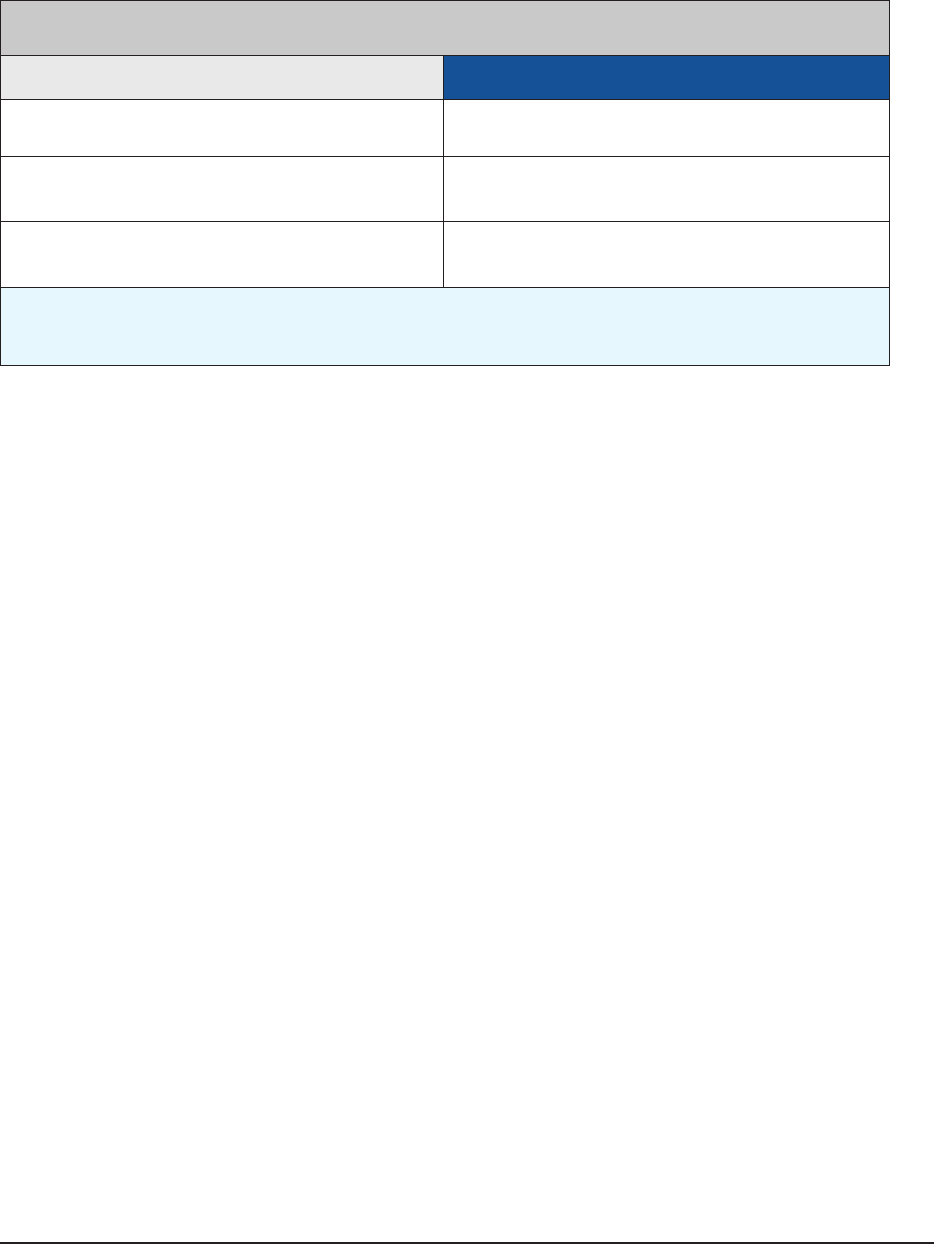
Supercharging Return on
Investment with Rapid
Applicaon Development Tools
Total Cost of Ownership White Paper
White Paper

Supercharging Return on Investment with Rapid Application Development Tools
2
Executive Summary
Today’s businesses are facing many nancial challenges, especially when it comes to developing IT
applicaons. New technologies have arrived on the scene that reduce those nancial burdens, while
speeding the applicaon development process. This white paper examines the FileMaker Plaorm,
which employs the Rapid Applicaon Development process, and how it oers certain advantages
over tools such as Oracle, Microso SQL Server, MySQL, and Salesforce.com that use more tradional
applicaon development methodologies.
The problems with the tradional applicaon development process:
Businesses have idened applicaon development projects as an area where signicant cost savings
can be realized, especially since cost overruns and delayed deliveries have become common problems.
The cause of those problems can be aributed to miscalculang training needs, prototyping costs, and
quality assurance costs, which are all related to the development of the applicaon. Further impacng
costs is the tendency of development projects to shi design goals or encounter new feature requests.
Those problems are further exacerbated by the rigid specicaon and development cycle associated
with tradional applicaon development tools.
Problems encountered during applicaon development negavely impact important business
performance metrics, such as Return on Investment (ROI) and Total Cost of Ownership (TCO), both
of which are used to gauge a project’s success. The soluon to those problems lies with the ability to
expedite the development cycle, reduce overhead, and quickly accommodate project modicaons,
which will enable developers to more eciently create, modify, and deliver new applicaons.
Solving problems with Rapid Applicaon Development (RAD) technologies:
Businesses today need agile IT soluons, which can react to market driven changes. Rapid Applicaon
Development (RAD) Tools, such as FileMaker Pro, have become the best way for businesses to
incorporate agility into their applicaon development projects. RAD tools deliver the ability to speed
development, reducing training needs, accelerate prototyping, and enable rapid project changes. Those
advantages combine to increase the ROI potenal, while reducing overall TCO. What’s more, RAD tools
help to lower ongoing operaonal costs by easing developmental changes throughout the life of the
project.
The Hidden Costs of Traditional Development Tools
Over the years, the tools used for applicaon development have become fragmented, meaning that
developers usually have to purchase suites of products, such as Microso Visual Studio 2008 and
Oracle Developer Suite 10g, which incorporate a multude of tools, ranging from code eding tools to
compilers to database connecon brokers. In most cases, those suites are incomplete at best and require
addional third party products, such as plug-ins, debuggers, database connectors, compilers, and a slew
of other “added expense” items, which tends to be true with development products such as Salesforce.
com Enterprise Edion. Even open source soluons, such as MySQL, do not escape the need for add-ons,
in many cases, deploying MySQL requires the purchase of commercial tools with signicant costs.
While increased product selecon and mulple opons may even result in new development
opportunies, IT departments are usually saddled with addional training requirements, licensing costs,
and integraon chores. Those costs oen increase exponenally and must be jused to prove the ROI
of a project. But, those addional expenses and increasing costs are only a small part of the problem.
The development tools selected for a project also signicantly impact the development process. The
tradional applicaon development method, oen referred to as stagewise or waterfall models, is

Supercharging Return on Investment with Rapid Application Development Tools
3
based upon a structured step-by-step approach for developing applicaons. While sound in theory,
the stagewise or waterfall approach leads to a rigid sequence of steps, which is anything but strategic.
Each procedural step consumes me and resources by forcing applicaon developers to “sign-o”
aer compleon. That results in procedures that freeze development unl each specicaon is coded,
tested, and implemented, before proceeding to the next step. In most cases, there is a long delay before
applicaons are completed and the development process can take so long that the fundamental needs
of the business could change before the new applicaon is implemented. While this is appropriate for
certain transaconal or nancial systems there might be a more appropriate approach for departmental
soluons.
Simply put, tradional tools and methodologies will signicantly increase realized TCO and will reduce
demonstrable ROI. It all comes down to the ineciencies of the tools, the methods and the overall
management of the process negavely impacng the boom line.
Rapid Application Development Paves a Better Path to Enhancing TCO
and Delivering ROI
RAD brings new tools and processes that change the fundamentals of building applicaons. RAD tools,
such as FileMaker Pro, replace the tedious hand-design and coding processes with automated design
and coding. That automaon delivers a multude of benets ranging from expeding applicaon
development to improving the agility of change management. Automaon speeds both development
and delivery by eliminang waterfall methodologies that isolate developers from subject maer experts.
FileMaker Pro naturally embraces a spiral approach that emphasizes iteraon and involves end users
during development to ensure success at delivery. Spiral development allows a project to be broken up
into smaller pieces, which can be developed concurrently and prototyped in manageable pieces. Each
part of the soluon can then be tested independently and then wrapped together to complete the
project. The spiral development methodology goes hand in hand with RAD to reduce the me needed to
develop applicaons, while increasing exibility.
The FileMaker Platform
The FileMaker Plaorm is a suite of tools used to easily build exible database soluons for rapid
deployment on Windows and Mac, and to extend them to the web. The product line consists of
FileMaker Pro, FileMaker Pro Advanced, FileMaker Server, and FileMaker Server Advanced. FileMaker
Pro is an encapsulated development and deployment plaorm – no addional tools are needed to
build and deploy applicaons. However many developers opt to use FileMaker Pro Advanced in order
to take advantage of the added customizaon and development tools included in the soware. If a
FileMaker applicaon needs to be securely shared, FileMaker Server is added to manage the databases.
Or FileMaker Server Advanced can be used to host even larger groups of databases, provide ODBC/JDBC
connecvity and share databases over the web with more users than FileMaker Pro alone.
The FileMaker Plaorm is ideal for:
Soluons that are currently based on spreadsheets or paper•
Retrieving and exchanging data with enterprise systems•
Data tracking, report generaon, and analysis •
Workow soluons for the department or workgroup•
The FileMaker Plaorm is designed to help the non-programmer (subject maer expert) become more
producve in collecng, processing, and analyzing informaon. The award-winning FileMaker Pro
provides the tools to build a customized user interface with a relaonal database and business logic in a

Supercharging Return on Investment with Rapid Application Development Tools
4
single unied Windows and Mac applicaon. Incorporang these three elements into one product has
proven to be very eecve and places a lighter cognive load on the knowledge worker or other users.
Tradional vs. FileMaker Architecture
Tradional Architecture FileMaker Architecture
User interface — HTML, JSP, ASP, or VB Object oriented user interface — FileMaker Pro
Business/Applicaon Logic — C++, .NET, C##,
OR J2EE/JAVA
Point and click Business/
Applicaon Logic — FileMaker Pro
Data — Oracle, MySQL, or DB2
Data — FileMaker Pro or connect to Oracle,
Microso SQL Server or MySQL
FileMaker’s integrated architecture means developers can quickly modify the user interface,
business logic, and schema.
FileMaker Pro signicantly improves ROI and reduces TCO by oering:
Faster Development Cycles:- A Rapid Applicaon Development environment speeds
development by eliminang coding, compiling and other me consuming tasks. A quick start
screen, built-in templates and other tools allow the creaon of applicaons, even by novice
users.
Codeless Applicaon Creaon:- An Integrated Design Environment eliminates manual coding
tasks and automacally creates scripts and other code elements for programmers. Help screens,
examples, and demonstraons are integrated into the product to show how to accomplish tasks.
Integrated Design Environment:- Simplies design and maintenance by providing graphical
tools, help, and ulies in a single interface. Developers do not need to launch (or purchase)
addional tools to complete a project, while integrated help provides troubleshoong advice
and ps to create applicaons or test prototypes.
Reduced Training Requirements: - Wizards coupled with graphical design elements makes geng
started quick and easy, allowing new users to skip tradional training. A logical development
process helps new developers quickly learn how to use FileMaker Pro and its associated tools,
while built-in example applicaons highlight funconality and provide starng points for
developing new applicaons.
Integrated Database:- A proprietary database can be used for prototyping or as a replacement
for an expensive SQL-based system. FileMaker Pro supports up to a million records, fast indexes
and includes tools that allow developers to examine data directly to build relaonships and
validate funconality.
Mulple External Database Connectors: - Access data from mulple sources and plaorms,
without needing expensive add-on tools or opons. FileMaker Pro can connect to industry
leading databases from Oracle, IBM, Microso, and many others. FileMaker Pro can develop
applicaons that leverage those exisng databases or work as an applicaon that can link
mulple disparate databases together to create unique cross-plaorm soluons.
Cross-Plaorm Support:- Develop for Windows or Mac OS systems with a single product.

Supercharging Return on Investment with Rapid Application Development Tools
5
Simplied Administraon:- FileMaker Pro includes wizards and concise tools to simplify database
maintenance chores, eliminang the manual tasks that are oen associated with maintaining
large databases, such as Oracle 10g. FileMaker Server provides remote database administraon,
the ability to schedule live backups, and scripts to automate administrave tasks.
Integrated Maintenance Tools:- Maintain, modify, and manage databases without having to
purchase addional tools, products, or add-ons.
Integrated Support for Web-Based Applicaons: - Deploy applicaons to the web, quickly and
simply with bundled tools and web server opons. FileMaker Pro supports publishing databases
to the web for as many as ve concurrent users, while FileMaker Server Advanced increases
concurrent web user counts to 100 users. PHP is supported in both FileMaker Server and
FileMaker Server Advanced.
Organizaons adopng FileMaker Pro and spiral development methodologies will realize several
benets, some of which reach beyond tradional ROI and TCO calculaons. As an applicaon
development tool, FileMaker Pro allows organizaons to move to a class of developers that are focused
on the business process and the dataset. Those developers are no longer saddled with the me
consuming intricacies of hand coding applicaons and can focus instead on building applicaons that
meet the needs of the business, instead of applicaons that are limited by the coding methodologies in
use. What’s more, elemental design changes are much easier with FileMaker Pro, thanks to a codeless
development environment that leverages graphical design tools, allowing developers to quickly “paint”
applicaon screens and then populate those screens with the necessary elements to automacally build
the business logic and code needed by the process. As a RAD tool, FileMaker Pro oers an Integrated
Design Environment (IDE). In the case of FileMaker Pro, the IDE provides tools that enable developers to
visually design the forms, menus, reports, tables, and so on, for applicaons using point-and-click and
drag-and-drop techniques. Those tools allow developers to see design results as they progress.
Rapid development and ease of use are only two elements of the FileMaker Pro advantage. Adopters will
also nd that FileMaker Pro uses a data-driven approach to development – where database management
and RAD are treated as a single element, instead of as two separate management ers. This allows
developers to easily incorporate granular security elements at the eld level, automate indexes, create
codeless sorts, or embed scripts. That unied approach also helps to simplify administraon, while
reducing the technical knowledge required to develop an applicaon.
Competitive Analysis: 3-Year TCO Study
There are several development tools on the market today – ranging from adhoc RAD soluons that
combine third-party IDEs with coding tools to all-in-one database soluons that incorporate RAD
like capabilies. While all have their benets, most are encumbered with shortcomings that become
apparent the further a development project progresses. Those shortcomings are a result of the limited
integraon between the various components used in the development environment. FileMaker Pro
overcomes those limitaons with a design that combines the three primary elements of a data-driven
soluon (database architecture, business logic, and user interface) into a single, inexpensive product.
Those features help most organizaons to meet a variety of development needs and do not require
addional add-on purchases. The fully integrated nature of those features directly improves TCO by
speeding developmental changes or by allowing the incorporaon of addional applicaon capabilies,
without requiring revisions to code or re-engineering the database and core applicaon.

Supercharging Return on Investment with Rapid Application Development Tools
6
Comparing the FileMaker Plaorm with products from Microso, Oracle, Salesforce and the open source
community reveals the long-term economic benets of the FileMaker Plaorm.
(Please see addendum for methodology)
First and foremost, the FileMaker Plaorm (referred to as the FileMaker Development Soluon in the
table below) proves to have a much lower inial licensing and tool set costs when compared to compeng
products – especially when a development soluon is scaled to handle a larger number of clients.
Salesforce.com and Force.com bundle the development environment costs into their licensing fees:
Database License Acquisition Costs 25 clients 50 clients 200 clients 1000 clients
FileMaker Development Solution $7,574 $13,049 $44,799 $157,995
MS SQL Server 2008 Enterprise Edition $13,969 $18,019 $42,319 $211,595
Oracle Database Standard Edition 11g $17,500 $17,500 $35,000 $175,000
MySQL $0 $0 $0 $0
Salesforce.com Enterprise Edition $112,500 $218,750 $900,000 $4,500,000
Force.com Enterprise Edition $15,000 $30,000 $120,000 $600,000
Development Environment (5 copies) 25 clients 50 clients 200 clients 1000 clients
FileMaker Pro Advanced $2,195 $2,195 $2,195 $2,195
Microsoft Visual Studio .NET 2008 $3,995 $3,995 $3,995 $3,995
Oracle Development Suite 10g $29,000 $29,000 $29,000 $29,000
MySQL (using IBM WebSphere Studio) $12,000 $12,000 $12,000 $12,000
Salesforce.com Enterprise Edition $0 $0 $0 $0
Force.com Enterprise Edition $0 $0 $0 $0
With the FileMaker Development Soluon, the cost of applicaon development drops signicantly,
thanks to the integrated tool set, codeless development capabilies, and rapid applicaon development
methodology. An enterprise can expect to reduce development costs by at least 60% when compared to
Salesforce.com Enterprise Edion and as much as 80% when compared to Microso Visual Studio .NET
2008:
Development Cost 25 clients 50 clients 200 clients 1000 clients
FileMaker Development Solution $78,750 $78,750 $78,750 $78,750
Microsoft Visual Studio .NET 2008 $405,000 $405,000 $405,000 $405,000
Oracle Development Suite (Java) $296,100 $296,100 $296,100 $296,100
MySQL (Java) $336,600 $336,600 $336,600 $336,600
Salesforce.com Enterprise Edition $202,000 $202,000 $202,000 $202,000
Force.com Enterprise Edition $202,000 $202,000 $202,000 $202,000
The FileMaker Development Soluon also oers signicant savings when it comes to deployment of the
applicaon. The compeve advantage oered by FileMaker is fueled by wizard-driven deployment tools,
as well as the availability of web-based applicaon access. FileMaker Pro can concurrently develop both
web accessible applicaons as well as mul-plaorm (Windows and Mac OS) applicaons, using a wizard-
driven approach. This allows developers to create soluons based upon end user needs and not plaorm
centric requirements, quickly and eciently. The FileMaker Development Soluon shows an incredible
savings of 94% when compared to Oracle and signicantly less expensive when compared to the hosted
soluons oered by Salesforce.com and Force.com:

Supercharging Return on Investment with Rapid Application Development Tools
7
Deployment Cost 25 clients 50 clients 200 clients 1000 clients
FileMaker Development Solution $1,575 $1,575 $1,575 $1,575
MS SQL Server 2008 Enterprise Edition $20,250 $20,250 $20,250 $20,250
Oracle Database Standard Edition 11g $23,688 $23,688 $23,688 $23,688
MySQL $16,830 $16,830 $16,830 $16,830
Salesforce.com Enterprise Edition $20,200 $20,200 $20,200 $20,200
Force.com Enterprise Edition $20,200 $20,200 $20,200 $20,200
When it comes to TCO, several other factors must be considered, ranging from personnel/stang costs
to training costs. The FileMaker Development Soluon oers signicant savings in all of those areas.
Savings can be realized because the FileMaker Development Soluon proves much easier to execute than
compeng products, saving personnel costs. The training requirements are also greatly reduced with
FileMaker Pro thanks to wizards, integrated help and codeless applicaon design. Those costs savings relate
directly to departmental stang budgets and prove to be a compelling economic argument for adopng
FileMaker:
DBA Cost 25 clients 50 clients 200 clients 1000 clients
FileMaker Development Solution $7,200 $7,200 $7,200 $14,400
MS SQL Server 2008 Enterprise Edition $15,480 $15,480 $15,480 $30,960
Oracle Database Standard Edition 11g $22,500 $22,500 $22,500 $45,000
MySQL $16,560 $16,560 $16,560 $33,120
Salesforce.com Enterprise Edition $9,000 $9,000 $9,000 $18,000
Force.com Enterprise Edition $9,000 $9,000 $9,000 $18,000
Development Toolset Training (3 devs) 25 clients 50 clients 200 clients 1000 clients
FileMaker Development Solution $5,235 $5,235 $5,235 $5,235
Microsoft Visual Studio .NET 2008 $78,600 $78,600 $78,600 $78,600
Oracle Development Suite 10g $39,500 $39,500 $39,500 $39,500
MySQL (using IBM WebSphere Studio) $25,700 $25,700 $25,700 $25,700
Salesforce.com Enterprise Edition $27,200 $27,200 $27,200 $27,200
Force.com Enterprise Edition $27,200 $27,200 $27,200 $27,200
With any large-scale applicaon development and deployment project, ongoing maintenance, support,
and upgrade costs are to be expected. Those costs, usually calculated over a 3-year period, prove to be
an important element for calculang the TCO. The straighorward approach to upgrades, scalability, and
automated maintenance in the FileMaker Development Soluon proves to oer signicant savings in those
areas, helping to further reduce the TCO, while increasing the ROI. Both Salesforce.com and Force.com
include some of those costs in their licensing fees, while MySQL, as an open source product, has no costs
for the actual code used for a plaorm upgrade:
Two Application Upgrades (dev time) 25 clients 50 clients 200 clients 1000 clients
FileMaker Development Solution $15,750 $15,750 $15,750 $15,750
Microsoft VisualStudio .NET 2008 $81,000 $81,000 $81,000 $81,000
Oracle Development Suite (Java) $59,220 $59,220 $59,220 $59,220
MySQL (Java) $67,320 $67,320 $67,320 $67,320
Salesforce.com Enterprise Edition $40,400 $40,400 $40,400 $40,400
Force.com Enterprise Edition $40,400 $40,400 $40,400 $40,400

Supercharging Return on Investment with Rapid Application Development Tools
8
Two platform upgrades over 3 years 25 clients 50 clients 200 clients 1000 clients
FileMaker Development Solution $4,482 $5,857 $17,707 $59,175
MS SQL Server 2008 Enterprise Edition $6,304 $7,754 $27,828 $139,140
Oracle Database Standard Edition 11g $11,550 $11,550 $23,100 $115,500
MySQL $0 $0 $0 $0
Salesforce.com Enterprise Edition $0 $0 $0 $0
Force.com Enterprise Edition $0 $0 $0 $0
Support/Maintenance 25 clients 50 clients 200 clients 1000 clients
FileMaker Development Solution $2,157 $2,157 $2,157 $2,157
MS SQL Server 2008 Enterprise Edition $5,156 $5,156 $5,156 $5,156
Oracle Database Standard Edition 11g $0 $0 $0 $0
MySQL $4,000 $4,000 $4,000 $20,000
Salesforce.com Enterprise Edition $0 $0 $0 $0
Force.com Enterprise Edition $0 $0 $0 $0
By combining acquision costs, development costs, maintenance costs, and support/maintenance
costs with ancillary costs, it becomes evident where FileMaker Pro ts in the TCO picture. In a best case
scenario, the FileMaker Development Soluon deployed for 1,000 users can save an organizaon $4.4
million over a 3-year period, when compared to a hosted soluon such as Salesforce.com Enterprise Edion:
Total cost of development
platform ownership
25 clients 50 clients 200 clients 1000 clients
FileMaker Development Solution $124,918 $131,768 $175,368 $337,232
MS SQL Server 2008 Enterprise Edition $636,774 $642,274 $686,648 $989,736
Oracle Database Standard Edition 11g $499,058 $499,058 $528,108 $783,008
MySQL $479,010 $479,010 $479,010 $511,570
Salesforce.com Enterprise Edition $411,300 $517,550 $1,198,800 $4,807,800
Force.com Enterprise Edition $313,800 $328,800 $418,800 $907,800
Although research indicates that signicant savings can be realized on new deployments, there are
situaons where those savings do not represent real world TCO. For example, if an organizaon has
a large investment in an Oracle Database soluon, it may not make sense to migrate over to a new
FileMaker-based soluon. The cost of replacing the old system may exceed the benets oered by the
new soluon. But, that may not preclude FileMaker from that organizaon. Since FileMaker Pro can
connect with other database technologies, organizaons that rely on other databases may sll be able
to use FileMaker to extend capabilies. Examples include using FileMaker for web deployments, report
generaon, simple database maintenance funcons, and so on. In other words, FileMaker Pro becomes
a supporng tool for the other technologies in use and sll improves TCO, while increasing the ROI of
future development projects.
ROI Case Study with Best Practices
Oncology Services Internaonal (OSI) is a medical equipment vendor based in Montebello, NY that
specializes in the sale and maintenance of refurbished medical linear accelerators and simulators used
for cancer treatment. OSI is the largest independent provider of refurbished oncology equipment and
maintenance services. The OSI business model is founded upon the tenants of maximizing ROI and
lowering TCO for its customers by providing clinics with equipment to care for cancer paents at a
signicantly lower cost than purchasing new devices. OSI has applied the same concepts behind ROI and
TCO internally to fuel growth of 10 percent per year. Achieving that growth rate meant paying careful
aenon to the technologies used to develop sales capabilies. That led OSI to deploy a comprehensive
FileMaker Pro soluon – created by FileMaker developer CAB inc.

Supercharging Return on Investment with Rapid Application Development Tools
9
Soluon Specics:
FileMaker soware-
New Millennium Genesis Accounng system-
WorldSync SyncDek-
Realized Benets Impacng ROI:
Ability to handle double the sales volume with no addion to administrave sta expense-
Provided nancial integrity and easy data access that facilitated the purchase of OSI by private -
equity group
Reduced customer receivables in the over 90 aging category which resulted in a substanal -
reducon in short term interest expenses incurred to fund daily operaons
Improvement of cash ow by reducing the billing cycle from 30 days to 1 day for eld service -
work and 1 week to 1 minute for contract billing.
Provide support for real me management reporng and eld service operaons where none -
previously existed.
Business Challenge:
To deploy an enterprise-level soluon to replace SMB accounng product, enhance CRM and integrate
exisng FileMaker Pro database soware used to generate service reports, control inventory, track
contacts, and manage customer relaonships. The new soluon needed to oer specialized accounng
funcons and nancial reporng that most standard accounng packages do not accommodate.
Due Diligence and Selecon Process:
An RFP was created to entertain bids from professional SQL and Oracle development rms. Several bids
were received, with the lowest quote coming in at $250,000, without customizaons and hardware.
That quote far exceeded the applicable budget and forced OSI to re-evaluate the SQL and Oracle
requirements and idenfy alternaves.
OSI was able to nd the New Millennium Genesis Accounng system, based on FileMaker Pro, and was
able to locate a development rm to modify the soware that was well versed in accounng soluons.
CAB inc. was able to build a soluon based on both FileMaker Pro and Genesis using spiral development
techniques that leveraged the RAD enabled IDE in FileMaker Pro.
Using incremental development techniques, CAB was able to help OSI automate the right processes at
the right me and eliminate “do over” program development costs. That kept costs low and maximized
the ROI potenal of the project. The development process focused on automang core business
funcons supporng the money-making components of the OSI business model rst. CAB and OSI then
implemented WorldSync’s SyncDek for service reports capture and parts le management.
Customer Benets:
For OSI, the soluon based on FileMaker soware has brought real meaning to the term return on
investment. By taking advantage of the eciencies of FileMaker Pro, the company has grown to 50 eld
service engineers without adding a single incremental administrave person.
TCO was lowered signicantly, when compared with compeng soluons. The FileMaker and Genesis
soluon, over ve years, has cost 28 percent less. Further enhancing the ROI is the fact that the total
sum included everything – soware, hardware, and custom development. Moreover, OSI has achieved
addional cost reducons. Savings were realized by cung nancing costs by reducing the billing cycle
from 30 days to less than 1, and also by reducing external audit fees.

Supercharging Return on Investment with Rapid Application Development Tools
10
Addendum: FileMaker Total Cost of Ownership Methodology
This study esmates the Total Cost of Ownership of a medium- to high-complexity database-backed
applicaon over a three-year period. Such an applicaon would have in the range of 20-40 database
tables. It would also have signicant implementaon of unique business rules.
For deployment scenarios, the 25, 50 and 200-client models assume a single database server. The
1,000-client scenario assumes ve database servers supporng an average of 200 users apiece.
Hardware pricing was not factored into the model, as it is not a major dierenator among plaorms.
In all cases (with the excepon of Salesforce) the systems were expected to be running on modern
machines. For the 25- and 50-client scenarios a one-processor machine is used, one two-processor
machine is used for the 200-client scenario, and ve two-processor machines are used for the
1,000-client scenario. The number of processors is relevant to those cases where the pricing is assessed
per processor.
Database license acquision costs: Both Microso SQL Server and Oracle Database oer both per-seat
and per-processor licensing. In both cases the per-processor licensing was more advantageous, so that
pricing was used here. Pricing is based on one- or two-processor machines as outlined above.
With specic respect to Salesforce.com/Force.com, the plaorm here is evaluated as a true custom
applicaon development tool. It was assumed that the custom applicaon model would not need to
take full advantage of the bundled CRM capabilies of Salesforce.com. Accordingly pricing for two
edions of Salesforce.com: the CRM Enterprise Edion, was used in the study which includes fuller CRM
funconality, and the Force.com Enterprise Edion, which is less expensive and includes much more
modest CRM funconality. This allows comparison between scenarios needing the full CRM funcon,
and those that concentrate on a purely custom applicaon.
Development environment: Five licenses of each of the respecve development environments were
budgeted. Though the standard FileMaker Pro client can be used as a development environment for
many development tasks, most developers prefer the richer development feature set of FileMaker Pro
Advanced.
Development costs: A development sta of one senior developer or technical architect and two more
junior developers was used for this scenario. For the FileMaker soluon this team will spend about 1,250
hours on development in an inial 4-month period, followed by about 40 hrs./month for the remaining
32 months. Twice as many hours will be required for Salesforce development, and three mes as many
hours for Java or .NET development, based on third-party development experience of these other client
technologies. Note that, although many business rules can be implemented in Salesforce.com using the
plaorm’s nave workows and approvals, the complex business rules oen exceed what those features
can deliver, necessitang database triggers and custom (Apex) coding.
Two applicaon upgrades: This category esmates development costs for the regular delivery of new
features into an applicaon. Each upgrade is assumed to consist of 5% changes and 5% new code. Thus
these codes represent a straight 20% of the original esmated development cost.
Deployment costs: Based on third-party developer experience of the relave complexity of deployment
in each of these plaorms, deployment costs were assessed as a percentage of original development
costs. The following percentages were assumed in the scenario: FileMaker Pro 1%, Microso SQL Server
and MySQL 5%, Oracle 8%, Salesforce.com 10%. For Salesforce.com, as stated above, the soluon is
assumed to be a complex applicaon with signicant use of Apex and VisualForce. Deploying such an
applicaon can be quite complex and me-consuming.

Supercharging Return on Investment with Rapid Application Development Tools
11
DBA Cost: A set number of hours per month for each plaorm, at market DBA rates, was used to
calculate this secon. For FileMaker and Salesforce.com 5 hrs./month were used, while for the remaining
plaorms had 10 hrs./month allocated for pure DBA me.
Development Toolset Training: The cost of both training and cercaon in these respecve plaorms is
used for this secon. For FileMaker the cost of taking the FileMaker Training Series for three developers
(The FileMaker plaorm has a single cercaon level, FileMaker Cered Developer) was used. For the
Microso training costs one Enterprise Applicaon Developer and two ASP.NET developers were used
for the scenario. For the Java-based toolsets the cost was based on one Cered Java Developer and two
Cered Java Associates. For Force.com, it was assumed three people were taking the training required
for Advanced Developer Cercaon.
In addion to the cost of the course themselves, the costs of the me, in hours, that must be spent
to take the courses and achieve cercaon were added. The Microso cercaons are parcularly
expensive due to the large number of courses that must be taken: nearly a dozen courses and nearly 400
hours of training in the case of the Enterprise Applicaon Developer cercaon.
Plaorm Upgrades: Several vendors include plaorm upgrades in the base licensing cost, under various
names such as “soware assurance” or “soware support.” Where such support was available as a
bundled price, the support costs were split out and noted in this secon. Readers should be aware that
some licensing costs they may see in the marketplace, especially for Oracle and Microso, may include
the soware assurance fees.
Support: The plaorm upgrades category covers maintenance in the sense of ongoing soware
upgrades. This category refers specically to incident-based technical support. The oerings here vary
quite widely. For FileMaker, the cost of a single user contact for unlimited support was used. Microso’s
licensing comes with some minimal phone support, so the price for 20 addional paid support incidents
over three years was added. Oracle bundles technical support with its licensing fees, as does Salesforce.
com. For MySQL, the price for the MySQL Network support on a per-server basis was used.
TCO Table and Methodology
TCO data collected and prepared by Soliant Consulng. Soliant creates data applicaons that support
business process improvement in organizaons around the country. Soliant focuses on rapid applicaon
development tools, specializing in Adobe Flex™, FileMaker Pro, Web/PHP and Salesforce.com.
About the Author
Frank J. Ohlhorst is an award winning technology journalist, professional speaker and IT business
consultant with over 25 years of experience in the technology arena. Ohlhorst has wrien for several
leading technology publicaons, including ComputerWorld, TechTarget, PCWorld, ExtremeTech, eWeek,
CRN and Toms Hardware. Ohlhorst has also contributed to business publicaons, including Entrepreneur
and BNET, contributed to mulple technology books and has wrien several white papers, case studies,
reviewers guides, and channel guides for leading technology vendors.

Supercharging Return on Investment with Rapid Application Development Tools
12
© 2010 FileMaker, Inc. All rights reserved. FileMaker is a trademark of FileMaker, Inc., registered in the U.S. and
other countries. The le folder logo is a trademark of FileMaker, Inc. All other trademarks are the property of their
respecve owners.
THIS DOCUMENT IS PROVIDED “AS IS” WITHOUT WARRANTY OF ANY KIND, AND
FILEMAKER, INC. DISCLAIMS ALL WARRANTIES, EITHER EXPRESS OR IMPLIED,
INCLUDING, BUT NOT LIMITED TO, THE IMPLIED WARRANTIES OF MERCHANTABILITY OR
FITNESS FOR A PARTICULAR PURPOSE, OR THE WARRANTY OF NON-INFRINGEMENT. IN
NO EVENT SHALL FILEMAKER, INC. OR ITS CONSULTANTS BE LIABLE FOR ANY DAMAGES
WHATSOEVER INCLUDING DIRECT, INDIRECT, INCIDENTAL, CONSEQUENTIAL, LOSS OF
BUSINESS PROFITS, PUNITIVE OR SPECIAL DAMAGES, EVEN IF FILEMAKER, INC. OR ITS
CONSULTANTS HAVE BEEN ADVISED OF THE POSSIBILITY OF SUCH DAMAGES. SOME
STATES DO NOT ALLOW THE EXCLUSION OR LIMITATION OF LIABILITY. FILEMAKER MAY
MAKE CHANGES TO THIS DOCUMENT AT ANY TIME WITHOUT NOTICE. THIS DOCUMENT
MAY BE OUT OF DATE AND FMI MAKES NO COMMITMENT TO UPDATE THIS INFORMATION.
